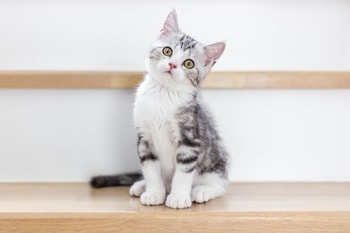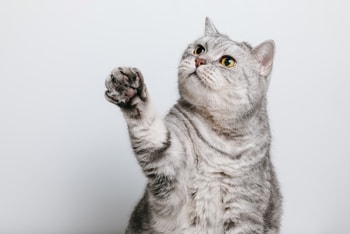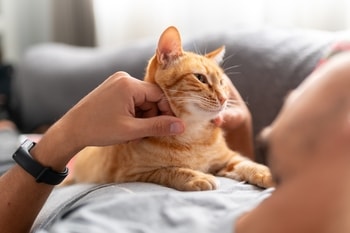If you’ve ever noticed your cat’s eyes looking red, swollen, or producing more discharge than usual, you might be dealing with pink eye in cats, also known as feline conjunctivitis. Pink eye in cats can be a concerning condition for pet owners, but the good news is that, with prompt treatment, most cases can be resolved. This blog’ll explore how to treat pink eye in cats, the different types of feline conjunctivitis, and what you need to know to help your furry friend feel better.
What is Pink Eye in Cats?
Pink eye, or conjunctivitis in cats, occurs when the thin mucous membrane covering the inner part of the eyelid and the white part of the eye becomes inflamed. Various factors, including bacterial infections, viral infections, allergens, or irritants, can cause this inflammation. The condition is common in cats and can affect one or both eyes.
The symptoms of pink eye in cats include redness, swelling, eye discharge, excessive tearing, squinting, or frequent blinking. Cats may also rub their eyes or show discomfort due to eye inflammation. While pink eye in cats can occur due to a mild infection, it can also be linked to more serious underlying health conditions like feline herpesvirus or bacterial infections.
Types of Conjunctivitis in Cats
Understanding the different types of conjunctivitis in cats is essential for proper treatment. Both infectious and non-infectious factors can cause pink eye. Below, we break down the main causes of conjunctivitis in cats:
1. Viral Conjunctivitis
Viral conjunctivitis in cats is often caused by the feline herpesvirus (FHV-1), a common cause of eye infections. Cats with feline herpesvirus often experience recurring eye infections, especially when their immune systems are weakened. Feline viral rhinotracheitis is another viral condition that can lead to cat conjunctivitis.
The symptoms of viral conjunctivitis in cats include watery or thick discharge from the eye, squinting, and redness. In severe cases, viral infections can cause damage to the cornea and lead to long-term eye discomfort.
2. Bacterial Conjunctivitis
Bacterial conjunctivitis in cats occurs when bacteria infect the conjunctiva. This type of conjunctivitis can develop as a secondary bacterial infection following viral infections, environmental irritants, or trauma to the eye. Bacterial conjunctivitis often presents with thick, yellow or green eye discharge, swelling, and irritation. It can be treated with antibiotics, either in the form of eye drops or oral antibiotics.
3. Allergic Conjunctivitis
Although less common, allergic conjunctivitis can affect cats, usually in response to environmental irritants like pollen, dust, or chemicals. Allergic conjunctivitis in cats may cause watery eyes, frequent blinking, and redness. Other signs of allergies, such as sneezing or itching often accompany this form of conjunctivitis.
4. Non-Infectious Causes
Non-infectious causes of conjunctivitis in cats may include foreign objects, eye trauma, or dry eye. If a foreign body, like a piece of dust or debris, gets into the cat’s eye, it can cause irritation and inflammation, leading to conjunctivitis. Additionally, conditions like feline immunodeficiency virus or feline leukemia virus can affect the immune system and make cats more susceptible to eye infections.
Symptoms of Pink Eye in Cats
 Identifying the symptoms of pink eye in cats is essential for early intervention. The main clinical signs of conjunctivitis in cats include:
Identifying the symptoms of pink eye in cats is essential for early intervention. The main clinical signs of conjunctivitis in cats include:
- Redness in the white part of the eye (sclera).
- Swelling or puffiness around the eye.
- Excessive eye discharge, which can be clear, yellow, or green.
- Frequent blinking or squinting.
- Eye discomfort may cause the cat to rub or scratch the affected eye.
- Tearing or watery eyes.
- Increased light sensitivity may cause the cat to seek out dark areas.
- Gooey or crusty eyes, especially in the morning.
If you notice any of these symptoms, it’s important to take action quickly to prevent further complications, such as secondary bacterial infections or damage to the cornea.
How to Treat Pink Eye in Cats
Now that we’ve discussed the causes and symptoms of pink eye in cats, let’s dive into how to treat it effectively. Treatment will depend on the underlying cause of the conjunctivitis.
1. Seek Veterinary Care
If your cat has pink eye, the first step is to seek veterinary care. A veterinarian will perform a thorough eye examination to determine the cause of the eye inflammation. Diagnostic testing, such as a swab of the eye discharge, may be necessary to identify whether the conjunctivitis is viral, bacterial, or due to other causes like allergies.
If your cat suffers from viral conjunctivitis, the veterinarian may recommend supportive care, as viral infections typically cannot be cured with antibiotics. In the case of bacterial infections, your vet may prescribe eye drops or oral antibiotics to treat the infection and prevent it from spreading.
2. Administer Eye Medications
Once your vet has diagnosed the type of conjunctivitis, they may prescribe eye medications such as antibiotic eye ointment or drops. It is essential to follow the vet’s instructions on how to administer these medications properly.
To administer eye drops or ointment, gently pull down the lower eyelid of the affected eye and place the prescribed medication inside. Be careful not to touch the tip of the bottle to your cat’s eye to avoid contamination. You may need to gently hold your cat still for a few seconds to ensure the medication stays in place.
3. Clean the Affected Eye
Keeping your cat’s eye clean is crucial in treating pink eye. If there is any eye discharge, use a wet cloth to wipe away the mucus and debris gently. This will help prevent crust build-up and reduce the risk of secondary bacterial infections. If your cat has difficulty tolerating the cleaning process, you may need to try doing it in short intervals, using a soft cloth to pull the inner corner of the eye gently.
4. Isolate Your Cat
Suppose the cause of the conjunctivitis is infectious, such as a viral or bacterial infection. In that case, it is important to isolate your cat from other pets to prevent the spread of the infection. Feline herpesvirus, for example, can be highly contagious, so keeping your cat away from other animals will help limit the risk of transmission.
5. Maintain a Healthy Immune System
In some cases, the immune system plays a role in the development and progress of pink eyes in cats. A healthy immune system can help fight off infections and reduce the severity of symptoms. Ensure your cat is eating a balanced diet, exercising regularly, and receiving proper veterinary care for any underlying health conditions. If your cat has a weakened immune system, such as in cases of feline leukemia or feline immunodeficiency virus, prompt treatment is especially important to prevent complications.
6. Treating Allergic Conjunctivitis
Suppose an allergic reaction, such as an environmental irritant cause your cat’s conjunctivitis. In that case, your vet may recommend allergy medication or advise you to eliminate potential allergens from your cat’s environment. Keeping your cat’s environment clean and reducing exposure to irritants like smoke or dust can help alleviate symptoms of allergic conjunctivitis.
7. Follow-Up Care
After starting treatment, it is important to follow up with your veterinarian to ensure that the infection is clearing up and that no complications are developing. If your cat is not improving or symptoms worsen, your vet may recommend further tests or adjustments to the treatment plan.
Prevention of Pink Eye in Cats
 Preventing pink eye in cats, or cat conjunctivitis, is important to ensure your furry friend’s eye health. While not all cases of conjunctivitis can be avoided, there are several steps you can take to reduce the risk of your cat developing the condition. Focusing on maintaining your cat’s overall health and minimizing exposure to infectious agents can help prevent eye discomfort and infections like feline herpesvirus (FHV-1), one of the leading causes of viral conjunctivitis in cats.
Preventing pink eye in cats, or cat conjunctivitis, is important to ensure your furry friend’s eye health. While not all cases of conjunctivitis can be avoided, there are several steps you can take to reduce the risk of your cat developing the condition. Focusing on maintaining your cat’s overall health and minimizing exposure to infectious agents can help prevent eye discomfort and infections like feline herpesvirus (FHV-1), one of the leading causes of viral conjunctivitis in cats.
1. Vaccination Against Feline Herpesvirus
One of the most effective ways to reduce the risk of cat conjunctivitis caused by feline herpesvirus is by vaccinating your cat. Feline herpesvirus is highly contagious and can lead to recurrent episodes of conjunctivitis, especially in cats with weakened immune systems. While the virus cannot be completely eradicated, vaccination can help lessen the severity of symptoms and reduce the frequency of flare-ups. The vaccine is typically administered as part of a routine feline vaccination protocol and is essential in preventing viral conjunctivitis caused by FHV-1.
If your cat has already been diagnosed with feline herpesvirus, treating conjunctivitis promptly is crucial to avoid further complications. Early treatment can help manage symptoms and reduce the risk of the infection worsening, leading to more severe issues like damage to the cornea or chronic eye problems.
2. Minimize Stress to Support the Immune System
Cat’s inflammatory immune response plays a crucial role in fighting infections, including those that cause cat conjunctivitis. Chronic stress can weaken your cat’s immune system, making them more susceptible to eye infections and other health problems. To minimize the risk of feline herpesvirus flare-ups and other infections, reducing stress factors in your cat’s environment is essential.
This includes creating a calm and quiet space for your cat, providing plenty of play opportunities, and offering a consistent routine. If your cat has experienced stressful events, such as moving to a new home or changes in the household, consider using calming aids like pheromone diffusers or consulting your veterinarian for advice on managing stress.
3. Cleanliness and Hygiene
Maintaining a clean living environment for your cat is essential to preventing cat conjunctivitis. Keep your cat’s bedding, litter box, and toys clean to reduce exposure to potential allergens and pathogens that can cause feline herpes virus or other bacterial infections. Regularly wash your cat’s bedding and any frequently used items to eliminate dust, bacteria, or viruses that may cause eye irritation.
Additionally, if you have multiple cats, be aware that feline herpesvirus is highly contagious, and an infected cat can easily spread the virus to others. Isolate an infected cat from other pets until they are fully treated to prevent the spread of the infection.
4. Regular Veterinary Check-Ups
Regular veterinary visits are important to ensure your cat’s overall health, including preventing cat conjunctivitis. A veterinarian can perform thorough eye exams, assess your cat’s immune system, and catch early signs of viral or bacterial infections. If your cat shows signs of eye discomfort, such as frequent blinking, tearing, or squinting, seek veterinary care as soon as possible.
For cats with known risk factors, such as feline herpesvirus or recurring eye issues, your vet may recommend regular eye exams or other preventive measures to catch potential problems before they worsen.
5. Maintain a Healthy Diet and Lifestyle
A strong immune system prevents infections like feline herpesvirus from causing cat conjunctivitis. Ensuring your cat is eating a balanced, nutritious diet will help support its immune system and reduce the likelihood of infections. Talk to your veterinarian about the best diet for your cat based on its age, health condition, and any underlying medical issues it may have.
Additionally, make sure your cat gets enough physical exercise and mental stimulation. Active cats are generally healthier and less prone to developing infections due to a strong immune response. Consider providing your cat with toys, scratching posts, or a cat tree to encourage movement and engagement.
6. Avoid Exposure to Environmental Irritants
Environmental irritants, such as smoke, dust, or strong chemicals, cause some cases of cat conjunctivitis. These irritants can trigger allergic conjunctivitis or exacerbate other underlying conditions like feline herpesvirus. To reduce the risk of irritation, avoid smoking near your cat and keep their living area free from strong chemical cleaners, perfumes, or cleaning agents that could cause allergic reactions.
Keeping windows closed during high pollen seasons can also help reduce exposure to allergens. If your cat has a history of allergic conjunctivitis, speak with your vet about possible environmental modifications to reduce allergens in your home.
7. Promptly Treat Conjunctivitis and Other Eye Infections
 If your cat shows any signs of conjunctivitis in cats, it’s important to treat cat conjunctivitis as quickly as possible. Early treatment can help prevent the infection from spreading or becoming more severe. If the cause is viral, such as feline herpesvirus, treatment will focus on managing symptoms and supporting the immune system. Antiviral medications may sometimes be prescribed, while bacterial conjunctivitis may require antibiotics to resolve.
If your cat shows any signs of conjunctivitis in cats, it’s important to treat cat conjunctivitis as quickly as possible. Early treatment can help prevent the infection from spreading or becoming more severe. If the cause is viral, such as feline herpesvirus, treatment will focus on managing symptoms and supporting the immune system. Antiviral medications may sometimes be prescribed, while bacterial conjunctivitis may require antibiotics to resolve.
Regardless of the cause, never delay treatment for eye infections. Prompt treatment can prevent long-term damage to the cat’s eye and ensure your cat’s vision remains healthy. If you’re unsure how to proceed, always seek veterinary care as soon as possible to get the right diagnosis and treatment plan.
Focusing on these preventive measures can help ensure your cat’s eyes remain healthy and reduce the chances of cat conjunctivitis and other eye infections. A proactive approach, including vaccinations, hygiene, stress reduction, and a healthy lifestyle, can go a long way in preventing eye problems caused by feline herpes viruses and other pathogens. Always work closely with your veterinarian to ensure your cat receives the appropriate treatment and care to keep them comfortable and healthy.
Conclusion
Suppose your cat shows signs of severe discomfort, such as eye rubbing, thick eye discharge, or an inability to open its eye. In that case, it’s important to seek veterinary care immediately. Early intervention can help ensure that the condition is properly treated and reduce the risk of complications.
In some cases, conjunctivitis may be a symptom of a more serious condition, such as feline herpes virus or a secondary bacterial infection. A prompt diagnosis will help guide appropriate treatment and improve your cat’s overall health.
Conclusion
https://www.pdsa.org.uk/pet-help-and-advice/pet-health-hub/conditions/conjunctivitis-in-cats
https://www.webmd.com/pets/cats/eye-discharge-in-cats
https://www.petmd.com/cat/conditions/eyes/c_ct_conjunctivitis




